Keith Anderson is the one who took my fascination with carbide tin cans and elevated it to the level of rocketry. I think we were 11 or 12 at the time. He said he heard from a kid that you could make rocket fuel just by cutting off a bunch of match heads. An intriguing concept to be sure, but my initial lab work to test the concept was not particularly successful. Lots of matches were hard to come by, especially without raising adult questions. There are only so many times I can justify lighting the little alcohol lamp that came with my chemistry set. So, unfortunately, we had to abandon that line of research.
More inquiries turned up rumors that rocket fuel could be made with some sort of charcoal and sulphur and saltpetre combination. Closer scrutiny cast some doubt on this, however. Saltpetre was used by farmers for some reason we couldn’t seem to understand. It was also (according to a friend’s older brother) used by the military to keep their soldiers from having a good time – whatever the heck that meant. How could anything like that be used for rocket fuel?
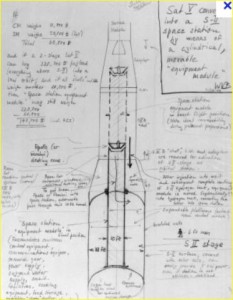 This is when I realized we might need to go to the library to find out more. I found a book by a guy named Goddard who made some early rockets. It had to be a good book because they said he was the Father of Rocketry right on the front cover. One of the first fuels he experimented with was saltpetre mixed with sugar. Eventually, he went on to use liquid oxygen and stuff like that. I decided to give the saltpetre another look because they talked about it in the first couple of chapters of the book. The beginning of the book was the easiest to understand, because each new chapter kept adding more drawings and formulas and diagrams and complicated stuff. Sticking to the first chapter would make things much easier. I admit the saltpetre and sugar didn’t really sound plausible, but the guy had written it in a book, so it had to be right.
This is when I realized we might need to go to the library to find out more. I found a book by a guy named Goddard who made some early rockets. It had to be a good book because they said he was the Father of Rocketry right on the front cover. One of the first fuels he experimented with was saltpetre mixed with sugar. Eventually, he went on to use liquid oxygen and stuff like that. I decided to give the saltpetre another look because they talked about it in the first couple of chapters of the book. The beginning of the book was the easiest to understand, because each new chapter kept adding more drawings and formulas and diagrams and complicated stuff. Sticking to the first chapter would make things much easier. I admit the saltpetre and sugar didn’t really sound plausible, but the guy had written it in a book, so it had to be right.
The next part of my plan was more complicated. How would I get my mom to help me acquire the saltpetre I needed? What if she asked me what I wanted it for? Would she accept that “I need it for a chemistry experiment.” I doubted it. She had a sharp and suspicious mind when it came to mysterious and smelly things coming from the basement. But, I took a chance, and after several days of nagging, she agreed to take me to a feed store.
The store smelled like a barn, but we found what we were looking for. In fact, they were selling it by the scoop. You just shovel how much you want into a bag. I’d hoped to get enough to fill a small bottle from my chemistry set. Instead, I came home with an unending supply.
Eager to begin my experiments, I went to my basement lab with my book and my new loot. I had to make a quick run back upstairs for a supply of sugar. Mom gave me some, although she questioned why I needed so much. I carefully mixed the sugar and the saltpetre together in the recommended ratio. I read the mixture had to be heated, and, if you did it right, it would turn into a liquid. They did say you shouldn’t let the temperature get above something like 325 degrees or something called “combustion” might happen. But that didn’t matter to me, because a) I didn’t have any way of measuring the temperature, b) I didn’t know what 325 degrees were, and c) what the heck was “combustion” anyway?
Reality can be a harsh teacher. Laws of Chemistry, I found, just hate to be ignored.
My little alcohol lamp was merrily heating the stuff in my test tube. And, it actually was turning into a liquid, just like the book said it would. Now at this point, you might think I should have known what to do next. But the book was kinda sketchy on that part. So I hadn’t really thought about what might come next. When the liquid in the test tube started boiling, all I was really thinking about was the interesting thick bubbles that were forming. Which is probably why I wasn’t expecting the explosion.
 On the scale of explosions, it wouldn’t be considered a huge explosion. In truth, I don’t even remember the sound. I do remember the mushroom cloud that leaped out of my little test tube. It shot up until it hit the ceiling, at which point it started spreading throughout the room. You know how everything seems to be in slow motion during an emergency? It was like that. I watched that demon cloud as it broke free, leaving its signature forever on my mind, indistinguishable from the nuclear bomb blasts we were taught to fear.
On the scale of explosions, it wouldn’t be considered a huge explosion. In truth, I don’t even remember the sound. I do remember the mushroom cloud that leaped out of my little test tube. It shot up until it hit the ceiling, at which point it started spreading throughout the room. You know how everything seems to be in slow motion during an emergency? It was like that. I watched that demon cloud as it broke free, leaving its signature forever on my mind, indistinguishable from the nuclear bomb blasts we were taught to fear.
The reason I knew there was sound from the explosion was because my mom came racing down the stairs and directly to my workbench where I sat in stunned silence. I knew I was in trouble. I hadn’t exactly offered full disclosure on how I intended to use that saltpetre. And I was pretty sure she wasn’t expecting it to be explosive. I knew she saw every detail of my deception clearly written on my face.
Instead, she surprised me by asking me in a rather angry voice, “Have you been smoking?!” What? Smoking? I was only 12. Why would I be smoking? That was when I realized she had seen all the smoke and drawn the wrong conclusion. I leaped on the opportunity to give her an explanation other than the one she feared most. I explained it was just a chemistry experiment. I tensed for the possibility she might change tack and begin a new line of interrogation into what kind of experiment causes explosions, but after checking my workspace for cigarette butts, she was satisfied and left.
Now some people might consider this experiment a failure. Not me. I had proven that whatever it is they feed to farm animals and soldiers had great explosive power. I just had to make sure to avoid the explosion part.
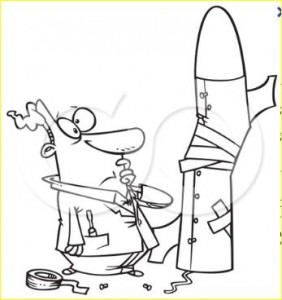 My inquiry soon shifted to another area. What was I going to use for a rocket? I certainly didn’t have any. Anything made of plastic would certainly not work. Rummaging through my dad’s workshop turned up an interesting possibility. It was a cardboard tube about a half-inch in diameter. This was perfect! I had limited permission to use dad’s power tools, so I used the jigsaw to turn a dowel into a nose cone for my rocket. I then taped it into place with electrical tape (none of that scotch tape stuff for us; my dad was an engineer and had all the good stuff). The next problem was wings. How do we make it go straight without wings? I found cardboard on the back of a pad of paper and cut out a triangle. I knew the wing had to handle the high wind speed and high G-forces during the moments after launch. So I used glue to hold my triangular wing in place.
My inquiry soon shifted to another area. What was I going to use for a rocket? I certainly didn’t have any. Anything made of plastic would certainly not work. Rummaging through my dad’s workshop turned up an interesting possibility. It was a cardboard tube about a half-inch in diameter. This was perfect! I had limited permission to use dad’s power tools, so I used the jigsaw to turn a dowel into a nose cone for my rocket. I then taped it into place with electrical tape (none of that scotch tape stuff for us; my dad was an engineer and had all the good stuff). The next problem was wings. How do we make it go straight without wings? I found cardboard on the back of a pad of paper and cut out a triangle. I knew the wing had to handle the high wind speed and high G-forces during the moments after launch. So I used glue to hold my triangular wing in place.
Mixing up a batch of rocket fuel was easy, now that I’d perfected the process. In fact, I made several process improvements by introducing a small pan that held 5-6 times more than my test tube. My final improvement was the introduction of a small glass stick to stir the liquid (and reduce the chance of that combustion thingy happening).
As soon as I finished the cooking, I set the pan aside to cool. Later, scraping out bits of the fuel, I poured the combination of nuggets and powder into my rocket’s body. I was ready. My rocket launch would be the first one ever seen on Crestwood Lane. I called my friend Keith over to witness my proudest moment.
I had to prop up the rocket with twigs to keep it pointing upright. And we had to use stones to hold the base of the rocket off the ground so I had room to get the match close to the fuel. You might be thinking a smarter way to light a rocket would be with a fuse, but there were none in my chemistry kit, so I had to improvise. It turns out the first few matches didn’t do the job. The reason for this is every time I thought the rocket might be lit, I would break into a mad 100-yard dash for shelter. Actually, none of the matches so far had started the rocket fuel burning. And I was rapidly running out of matches. Going back to Mom for more matches was not an option. So I had to be strong, for the sake of the launch, and hold the match in place until ignition was confirmed. Ignition, it turns out, is not shy about giving confirmation. The only problem is ignition seems to turn almost instantly into launch, which doesn’t leave as much time as one would like to run away.
On this day, Dr. Goddard’s spirit was with us and everything went right. Flames shot out of the bottom of the rocket, thrusting it upward. It zoomed up and up, leaving a trail of smoke behind it as it made its ascent. I admit it didn’t go perfectly straight; it actually seemed to do a lot of twisting and turning and a little wobbling, but it was close enough. And when it had spent all its fuel, it turned around and fell to the earth. It fell straight down (aided by the weight of the dowel nose cone and the wing). It landed in the grass, with its tail sticking up in the air. This was to be one of my best launches.
I was ready to run back to the basement and mix up more fuel, but it was not to be. The little rocket’s butt was burned to a cinder. In fact, we’d lost at least 3/4 inch off the length of the rocket because of the hot exhaust. And the walls of the rocket where very thin in several spots. It looked like the rule would be: one rocket, one launch.
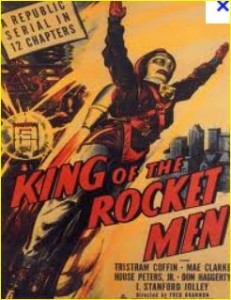
And thus began the adventures of the Rocket Boy of Crestwood Lane.

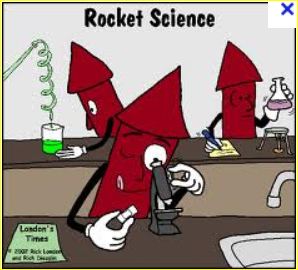 Over the next few months, I experimented with different rocket bodies made from many different substances. I created special wooden nozzles for the rockets that would give greater compression and lift to the rockets. I experimented with different wing designs. I tested different mixes for the rocket fuel, including powder fuel vs. solid fuel. All of these unique rocket designs had one thing in common, which my mom summed up rather well. “They’re just sticks of dynamite with fins glued on,” she said.
Over the next few months, I experimented with different rocket bodies made from many different substances. I created special wooden nozzles for the rockets that would give greater compression and lift to the rockets. I experimented with different wing designs. I tested different mixes for the rocket fuel, including powder fuel vs. solid fuel. All of these unique rocket designs had one thing in common, which my mom summed up rather well. “They’re just sticks of dynamite with fins glued on,” she said.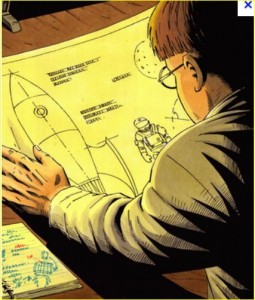 The rocket design changed over time, as you might expect. I eventually settled on a process that involved cutting a wooden dowel into two pieces. The first piece was sharpened to a nice point to ensure minimal air resistance. The second dowel had a hole drilled through the center, which was a technique I designed to increase the rocket’s thrusting power.
The rocket design changed over time, as you might expect. I eventually settled on a process that involved cutting a wooden dowel into two pieces. The first piece was sharpened to a nice point to ensure minimal air resistance. The second dowel had a hole drilled through the center, which was a technique I designed to increase the rocket’s thrusting power. Now, I have to admit what my mom said about my rockets was mostly true (about sticks of dynamite with fins glued on). And you can imagine all the time I spent picking up small bits of paper from exploded rockets that had been blown all over our driveway and lawn. But I wasn’t discouraged. I knew it was just a matter of time before I got it right. And besides, my reputation for rocketry was becoming legendary among my friends. They even started calling me One-Match-Steve. All my friends were of the stick-the-match-sorta-close-and-then-run-away-as-fast-as-you-can types. I, on the other hand, was the only kid stupid enough to hold the match steady until the rocket started burning. It didn’t matter. I wore my new nickname with pride and dignity.
Now, I have to admit what my mom said about my rockets was mostly true (about sticks of dynamite with fins glued on). And you can imagine all the time I spent picking up small bits of paper from exploded rockets that had been blown all over our driveway and lawn. But I wasn’t discouraged. I knew it was just a matter of time before I got it right. And besides, my reputation for rocketry was becoming legendary among my friends. They even started calling me One-Match-Steve. All my friends were of the stick-the-match-sorta-close-and-then-run-away-as-fast-as-you-can types. I, on the other hand, was the only kid stupid enough to hold the match steady until the rocket started burning. It didn’t matter. I wore my new nickname with pride and dignity. That was when things took a turn for the worse. More precisely, the rocket decided it had enough of this “up” stuff and decided to try a little “sideways” stuff. It didn’t like that very much so it quickly switched to “down” stuff and then “over” and “back” stuff. I remember marveling at what an interesting display of zigs and zags was taking place before my eyes. Somewhere out of the corner of my eye, I was aware that Keith was running at top speed in the opposite direction. But I couldn’t be bothered with that now. This was history in the making. I almost forgot to move when one of the zags started heading straight at me. But at the last second, a new zig forced it up. It got about 25 feet up when it began a new maneuver. This one I call a spin-in-place. You often have to develop a new vocabulary to describe the varied takeoff sequences, especially if you haven’t quite worked out some of problems with the wings. So naturally my journal is full of technical terms like “spin-in-place”, “zig zag maneuver”, “twisty”, “shaky”, and “wabbly”.
That was when things took a turn for the worse. More precisely, the rocket decided it had enough of this “up” stuff and decided to try a little “sideways” stuff. It didn’t like that very much so it quickly switched to “down” stuff and then “over” and “back” stuff. I remember marveling at what an interesting display of zigs and zags was taking place before my eyes. Somewhere out of the corner of my eye, I was aware that Keith was running at top speed in the opposite direction. But I couldn’t be bothered with that now. This was history in the making. I almost forgot to move when one of the zags started heading straight at me. But at the last second, a new zig forced it up. It got about 25 feet up when it began a new maneuver. This one I call a spin-in-place. You often have to develop a new vocabulary to describe the varied takeoff sequences, especially if you haven’t quite worked out some of problems with the wings. So naturally my journal is full of technical terms like “spin-in-place”, “zig zag maneuver”, “twisty”, “shaky”, and “wabbly”.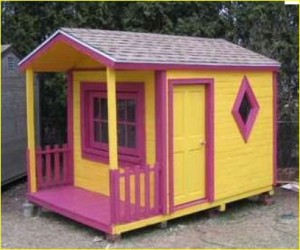 At this point, the only other kid with the guts to participate in my advanced research was Keith. We never called him One-Match-Keith, but in his own way, he had courage. He had a chemistry set of his own, and he had access to his sister’s outdoor doll house which we quickly converted to a mobile lab. It was here we hit on the best combination of rocket fuel.
At this point, the only other kid with the guts to participate in my advanced research was Keith. We never called him One-Match-Keith, but in his own way, he had courage. He had a chemistry set of his own, and he had access to his sister’s outdoor doll house which we quickly converted to a mobile lab. It was here we hit on the best combination of rocket fuel.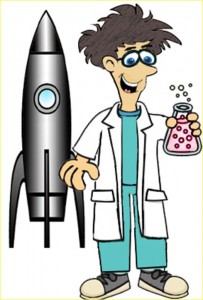 Then came the day we discovered the perfect combination of ingredients. We knew when we finished the cooking process that it had potential, but it wasn’t until we gave it the BB-Fire Test that we knew what we had. Instead of sitting still and producing a nice big flare, this little BB burned so hot and so fast, it launched itself. It didn’t need to be in a rocket or anything. It just flew. And, since we were inside a 6 x 8 foot doll house, the flying BB bounced from wall to wall like a bullet. Keith and I ducked and dodged that flaming pellet from Hell. Eventually, it was quiet. When the smoke cleared out of the doll house, we examined ourselves for burn holes, but it seemed we’d been spared.
Then came the day we discovered the perfect combination of ingredients. We knew when we finished the cooking process that it had potential, but it wasn’t until we gave it the BB-Fire Test that we knew what we had. Instead of sitting still and producing a nice big flare, this little BB burned so hot and so fast, it launched itself. It didn’t need to be in a rocket or anything. It just flew. And, since we were inside a 6 x 8 foot doll house, the flying BB bounced from wall to wall like a bullet. Keith and I ducked and dodged that flaming pellet from Hell. Eventually, it was quiet. When the smoke cleared out of the doll house, we examined ourselves for burn holes, but it seemed we’d been spared.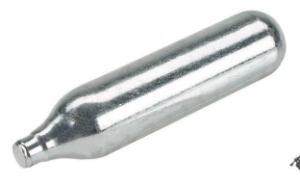 Now in our neighborhood, not all kids are the same. I was a BB gun kid. Some kids had pellet guns, which required you to pump up the air pressure for each pellet. Keith was one of those rare kids who had a CO2 powered pellet gun. When I saw that cool empty CO2 cartridge, I knew we had to do something with it. Nothing this perfectly formed should be thrown away. That’s when I realized it would make the perfect body for a small rocket. It was made of metal! And it already had a natural nozzle built into the end of it. And, if it worked out, we could easily get more of them. Perfect, perfect, perfect!
Now in our neighborhood, not all kids are the same. I was a BB gun kid. Some kids had pellet guns, which required you to pump up the air pressure for each pellet. Keith was one of those rare kids who had a CO2 powered pellet gun. When I saw that cool empty CO2 cartridge, I knew we had to do something with it. Nothing this perfectly formed should be thrown away. That’s when I realized it would make the perfect body for a small rocket. It was made of metal! And it already had a natural nozzle built into the end of it. And, if it worked out, we could easily get more of them. Perfect, perfect, perfect! I stood there in shocked disbelief. There were no little paper shards falling to the ground. That little rocket was gone-gone-gone. And with the force of that explosion, I knew it could have gone anywhere it wanted to go. I looked around the immediate area to see if there was a hunk of exploded metal lying somewhere on the ground. I didn’t see any metal shards, but I did see Keith’s heels as he continued sprinting through the field toward his house.
I stood there in shocked disbelief. There were no little paper shards falling to the ground. That little rocket was gone-gone-gone. And with the force of that explosion, I knew it could have gone anywhere it wanted to go. I looked around the immediate area to see if there was a hunk of exploded metal lying somewhere on the ground. I didn’t see any metal shards, but I did see Keith’s heels as he continued sprinting through the field toward his house. And so, I went into my house. At best it might take a day before their bodies were discovered. But after that, it would be simple to calculate from the hole in the side of the house the direction from which the rocket had come. I knew I needed to put my affairs in order. They would be coming for me soon. But I didn’t want to make it too easy, so I said nothing. I just stoically awaited my fate. When they came for me, I would calmly admit everything. Through that night and all the next day, I waited. Still they did not come. Nor did I see any police cars or ambulances. Nor did I see Keith, although I am sure he watched for police cars from his bedroom window.
And so, I went into my house. At best it might take a day before their bodies were discovered. But after that, it would be simple to calculate from the hole in the side of the house the direction from which the rocket had come. I knew I needed to put my affairs in order. They would be coming for me soon. But I didn’t want to make it too easy, so I said nothing. I just stoically awaited my fate. When they came for me, I would calmly admit everything. Through that night and all the next day, I waited. Still they did not come. Nor did I see any police cars or ambulances. Nor did I see Keith, although I am sure he watched for police cars from his bedroom window. Now, years later, I can’t tell you why, but I never built another rocket after that. Maybe it was because I became interested in girls. Or maybe another hobby came along and displaced my interest in rockets. But I think it was simpler than that. I think there are times in your life when some cosmic force reaches down to give you a good emotional shaking. Kinda like God’s way of saying, “What’s the matter with you? Are you nuts? Stop that!!”
Now, years later, I can’t tell you why, but I never built another rocket after that. Maybe it was because I became interested in girls. Or maybe another hobby came along and displaced my interest in rockets. But I think it was simpler than that. I think there are times in your life when some cosmic force reaches down to give you a good emotional shaking. Kinda like God’s way of saying, “What’s the matter with you? Are you nuts? Stop that!!”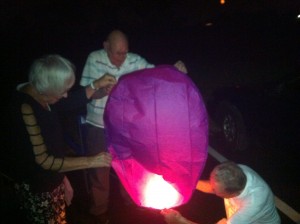 This time, Dad came forward to help. I was pleased. A trained engineer is always a welcome addition in any high-risk endeavor involving fire. Dad watched carefully, like the professional manager he is, leaving the details to other members of his team. This time the launch was flawless. I was busy taking pictures to mark the moment. Ardis was still worried about leaving fingerprints, but I told her that didn’t matter any more because there would be a picture of her doing the deed on the internet within a day. With such evidence, no one needed fingerprints. And no denials were possible.
This time, Dad came forward to help. I was pleased. A trained engineer is always a welcome addition in any high-risk endeavor involving fire. Dad watched carefully, like the professional manager he is, leaving the details to other members of his team. This time the launch was flawless. I was busy taking pictures to mark the moment. Ardis was still worried about leaving fingerprints, but I told her that didn’t matter any more because there would be a picture of her doing the deed on the internet within a day. With such evidence, no one needed fingerprints. And no denials were possible.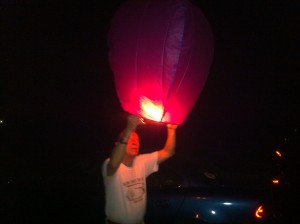 And so went the fourth launch. Absolutely flawless. With a team like this, the Russians would never have beat us in the Space Race.
And so went the fourth launch. Absolutely flawless. With a team like this, the Russians would never have beat us in the Space Race.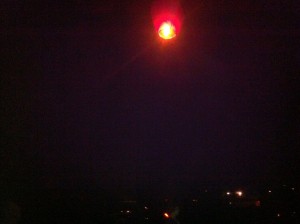 But tonight was our night. We were amazing.
But tonight was our night. We were amazing.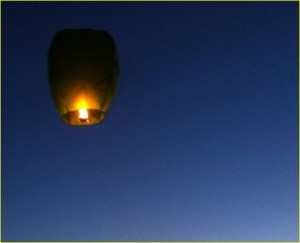 It was windy on the beach, even by Lake Michigan standards, so we gathered to light the first one in the shelter of one of the dunes. I was the self-appointed torch man whose job was to get the fire started. There were 2-3 others who helped hold the lantern upright; the others were busy shouting out instructions and encouragement to the rest of us. The fire wasn’t too hard to start. The real problem was holding the lantern steady and upright so it could fill with the hot air. And, of course, the wind didn’t help. It swirled around us, trying to put the fire out. And then, when the fire was going well, the wind changed tactics and tried to rip the lantern out of our hands. But we didn’t let any of that happen, and slowly, the lantern filled with hot air. Eventually, we knew the time was right, and we released the lantern. And watched as the lantern moved slowly upward into the darkening sky.
It was windy on the beach, even by Lake Michigan standards, so we gathered to light the first one in the shelter of one of the dunes. I was the self-appointed torch man whose job was to get the fire started. There were 2-3 others who helped hold the lantern upright; the others were busy shouting out instructions and encouragement to the rest of us. The fire wasn’t too hard to start. The real problem was holding the lantern steady and upright so it could fill with the hot air. And, of course, the wind didn’t help. It swirled around us, trying to put the fire out. And then, when the fire was going well, the wind changed tactics and tried to rip the lantern out of our hands. But we didn’t let any of that happen, and slowly, the lantern filled with hot air. Eventually, we knew the time was right, and we released the lantern. And watched as the lantern moved slowly upward into the darkening sky.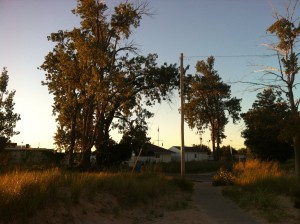 That was when I realized our sky lantern was not heading out over Lake Michigan. To be honest, I knew the wind was blowing north, but I thought it would be shifting toward the north-west, which would have been fine. As I took in more of the surroundings than just the lantern, I realized 1) the lantern was not heading out toward the water, but instead was moving north-east, 2) there is a line of trees in that direction, 3) the trees marked the boundary of the Coast Guard Station, and 4) the wind about 10-20 feet above the ground was moving hard and fast toward the trees. My poor lantern had no chance. He struggled to gain altitude. But the wind held him down. The nasty wind drove our helpless lantern relentlessly on a direct collision course with the trees. There was never really any hope. Our lantern tried to move around the trees, but the wind pushed him this way and that, never waivering from its target. Suddenly, it looked as if the lantern might have out-maneuvered the wind, but then a tree branch reached out and grabbed the lantern and held it tight. My heart sank as I saw my little friend trapped and without hope. Meanwhile, the wind and the tree were busy giving each other high-fives in celebration.
That was when I realized our sky lantern was not heading out over Lake Michigan. To be honest, I knew the wind was blowing north, but I thought it would be shifting toward the north-west, which would have been fine. As I took in more of the surroundings than just the lantern, I realized 1) the lantern was not heading out toward the water, but instead was moving north-east, 2) there is a line of trees in that direction, 3) the trees marked the boundary of the Coast Guard Station, and 4) the wind about 10-20 feet above the ground was moving hard and fast toward the trees. My poor lantern had no chance. He struggled to gain altitude. But the wind held him down. The nasty wind drove our helpless lantern relentlessly on a direct collision course with the trees. There was never really any hope. Our lantern tried to move around the trees, but the wind pushed him this way and that, never waivering from its target. Suddenly, it looked as if the lantern might have out-maneuvered the wind, but then a tree branch reached out and grabbed the lantern and held it tight. My heart sank as I saw my little friend trapped and without hope. Meanwhile, the wind and the tree were busy giving each other high-fives in celebration.
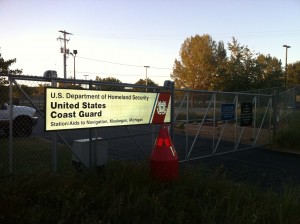 A quick calculation of the wind direction revealed that once again the Coast Guard Station was to be its target. But this time, it would not be a tree. This time, it would be the building itself that would burn. A Coast Guard tree going up in flames might be considered a foolish prank, but a second attempt on the same day would surely brand me as a terrorist. If only it hadn’t been a military installation the wind had chosen. How I hated him for this awful betrayal!
A quick calculation of the wind direction revealed that once again the Coast Guard Station was to be its target. But this time, it would not be a tree. This time, it would be the building itself that would burn. A Coast Guard tree going up in flames might be considered a foolish prank, but a second attempt on the same day would surely brand me as a terrorist. If only it hadn’t been a military installation the wind had chosen. How I hated him for this awful betrayal!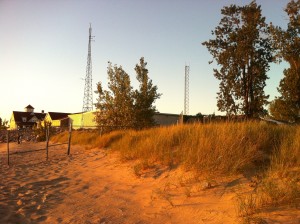 Suddenly, the lantern was pushed down again. It was now only 3-4 feet off the ground. And picking up speed. I saw the fence that surrounds the Coast Guard property. I desperately hoped the lantern would get caught by the fence. Maybe then it would not endanger the lives of the military people living there. Suddenly, the wind began lifting the lantern. That was when I realized the wind’s fiendish plan. The wind had hoped I would give up, thinking the fence would save me. The wind knew I would be stopped by the fence. He also knew he and the lantern could easily sail over it and go on to the building just a few feet away. I, however, would be powerless on this side of the fence, left with nothing to do but watch the building as it burned to the ground. I wondered if I could climb the fence. I also wondered if trespassing on a military base would be excused if I did it to put out a fire. Maybe. But a fire that I caused? Maybe not.
Suddenly, the lantern was pushed down again. It was now only 3-4 feet off the ground. And picking up speed. I saw the fence that surrounds the Coast Guard property. I desperately hoped the lantern would get caught by the fence. Maybe then it would not endanger the lives of the military people living there. Suddenly, the wind began lifting the lantern. That was when I realized the wind’s fiendish plan. The wind had hoped I would give up, thinking the fence would save me. The wind knew I would be stopped by the fence. He also knew he and the lantern could easily sail over it and go on to the building just a few feet away. I, however, would be powerless on this side of the fence, left with nothing to do but watch the building as it burned to the ground. I wondered if I could climb the fence. I also wondered if trespassing on a military base would be excused if I did it to put out a fire. Maybe. But a fire that I caused? Maybe not. For some reason, my friends failed to understand the situation as I did. When I returned to them, still dragging the dead lantern behind me, I did not receive the accolades that were my due. Instead, I was greeted by laughter and ribbing about how fast I had taken off running. Did they not see my heroism and the ultimate sacrifice made by my little friend? Did they not understand the terrible peril that had been averted? Did they not picture me in a federal lockup somewhere?
For some reason, my friends failed to understand the situation as I did. When I returned to them, still dragging the dead lantern behind me, I did not receive the accolades that were my due. Instead, I was greeted by laughter and ribbing about how fast I had taken off running. Did they not see my heroism and the ultimate sacrifice made by my little friend? Did they not understand the terrible peril that had been averted? Did they not picture me in a federal lockup somewhere?